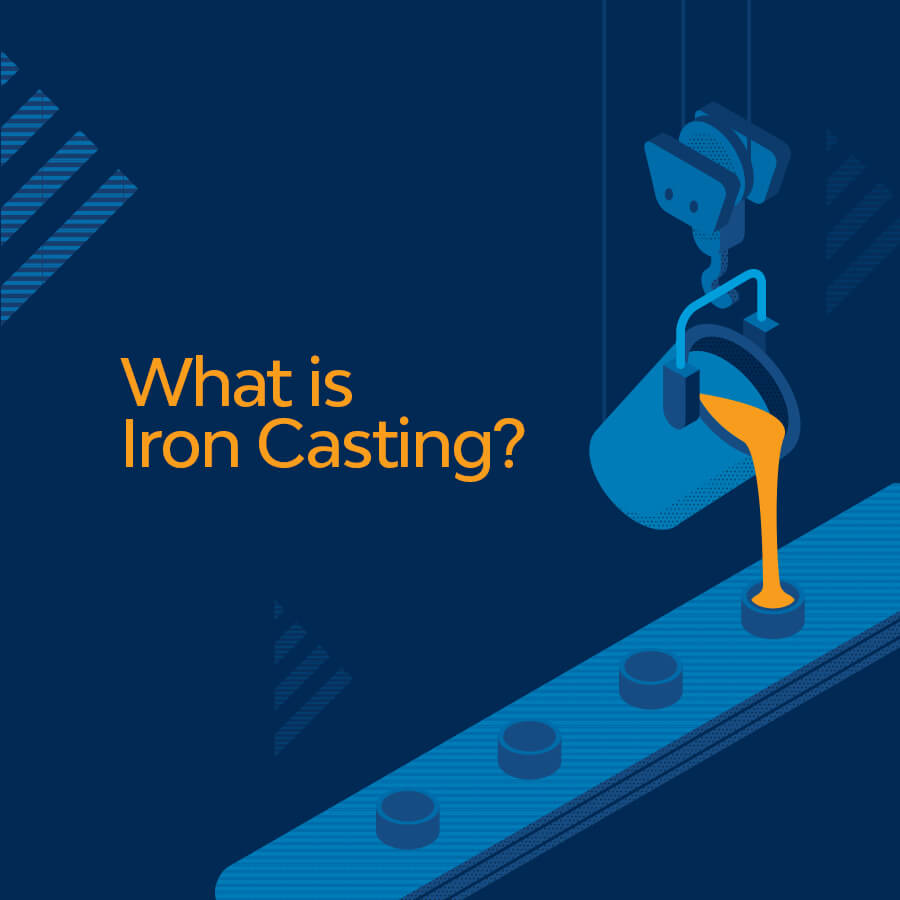The tale of cast iron dates back to the origins of human society. This rich history is filled with tales of extraordinary weaponry and stunning artistry that involved iron. Based on certain archaeological discoveries, the advent of iron casting can be traced back to around 6000 B.C. in Mesopotamia. While the Greeks and Romans were familiar with the craft of iron casting, real progress was made by China. Having learned from the migrating artisans from Mesopotamia, the Chinese were the first to consistently and successfully produce iron castings, beginning around 800 to 700 B.C.
Later, cast iron saw a significant turning point during the Industrial Revolution in the 18th and 19th centuries. Finally, the evolution of cast iron with superior mechanical properties happened in the late 1920s and early 1930s.
While other metals and alloys like aluminum, steel, brass, bronze, magnesium, etc. have been used for casting needs, iron castings have a distinct advantage on various parameters. Iron castings come with features like exceptional strength, durability, damping properties, functional versatility, and cost-effectiveness.
What is Cast Iron?
Cast iron is one of the oldest types of iron used for making things. It’s made mainly from iron, carbon, and silicon, with a bit of sulfur, manganese, and phosphorus sometimes. The carbon in it can be between 2% and 5%. To make cast iron, they heat iron ore in a special oven called a blast furnace. This turns the iron ore into liquid iron, which is then poured into molds to make solid pieces, often shaped like blocks called “pigs.”
Cast iron is good at resisting rust and damage because of its high silicon levels. It forms a tough layer that stops things like rust from eating into it. People use iron castings in things that need to last a long time and not get easily damaged.
There are five main types of cast iron, depending on what they are manufactured and how they’re structured in metallurgical process:
- Gray cast iron
- Ductile cast iron
- White cast iron
- Malleable cast iron
- Compacted graphite iron
Iron castings are utilized in a variety of sectors including construction, mining equipment, engine production, valve and pump manufacture, automotive, agricultural machinery, kitchenware, household appliances, as well as oil and natural gas extraction and processing tools.
Properties of Cast Iron
The characteristics of cast iron types are shaped by their solidification and cooling process. The properties of the cast iron rely on the cooling pace, molding procedure, temperature at which it is poured, and method of injecting the molten iron into the cavity.
Below are the top properties of cast iron:
High Strength
While cast iron is typically associated with its impressive compressive strength, cast iron also demonstrates a significant ability to withstand tension. This property makes it valuable in applications where materials need to endure pulling forces. In situations such as bridges and structural supports, cast iron’s robust tensile strength ensures the structural integrity and safety of these constructions. This characteristic contributes to its use in various industrial settings, including the production of cables and wire components that demand reliable tensile strength.
Vibration Damping
Vibrations can weaken structural elements, frequently resulting in disastrous breakdowns and decreased output. For most cast iron materials, suppressing vibrations is a critical feature. Other metals are prone to extreme vibration and this is where cast iron differentiates itself by its damping quality that minimizes vibrations. Therefore, it can be used for brake calipers, responsible for holding the brake pad, and engine mounts.
Ductility
Ductility refers to a material’s capacity to undergo deformation without fracturing. While not as ductile as some other metals like steel, cast iron can be shaped and molded to some extent. This property is advantageous in applications where intricate or custom shapes are required, such as decorative elements in architecture, ornamental railings, and artistic cast iron designs. Ductile cast iron shows impressive ductility among all types of cast iron categories.
Elongation
Elongation, a measure of how much a material can stretch before breaking, is also one of the properties of cast iron, particularly the ductile one. Cast iron may not be as elongating as some other materials like plastics, but it still possesses a degree of elongation that allows it to absorb energy before reaching its breaking point. This property is particularly useful in applications where impact resistance is crucial, such as in machinery components subjected to sudden forces or in automotive parts designed to absorb energy during collisions.
Machinability
The high machinability of cast iron, and its ease of shaping, cutting, and processing through different machining methods, are widely recognized. This characteristic proves beneficial in manufacturing scenarios, aiding in the efficient creation of complex parts while minimizing production duration and expenses. The feature of machinability facilitates precise engineering in sectors such as automobile manufacturing, necessitating strict tolerances and refined finishes in engine components and other parts.
Corrosion Resistance
Cast iron exhibits a robust resistance to damage when subjected to damp or chemically aggressive surroundings, preserving its structural wholeness. This trait is especially vital in sectors like marine, oil and gas, and chemical processing where components are perpetually subjected to severe conditions. The ability of cast iron to resist corrosion guarantees extended durability for these components and minimizes the need for maintenance. Consequently, it is an economically viable option for many uses.
Thermal Expansion
In engineering and construction, the thermal expansion characteristic of cast iron holds significant importance. Cast iron exhibits a comparatively minor degree of thermal expansion, which implies that its size doesn’t alter much with temperature variations. This characteristic guarantees that cast iron-made structures or components sustain their form and structural robustness under differing temperatures. It becomes especially beneficial in uses such as pipelines and railway systems, where temperature changes are frequent, and maintaining consistent dimensions is vital to avoid any structural complications.
Durability
Cast iron is frequently employed in scenarios where robustness and durability are key. Vital sectors like automotive, construction, and manufacturing depend on cast iron for parts that need dependable performance in tough settings. Be it for engine blocks, piping, or parts of machinery, cast iron offers the requisite toughness and resilience for maximum efficiency and lifespan.
Heat Retention
The remarkable heat-holding capacity of cast iron is widely acknowledged, making it fitting for diverse applications, from cookware to industrial equipment. The steady and reliable heat source that cast iron provides makes it an essential material for industrial procedures that demand prolonged heat duration.
Impact Resistance
The durability of cast iron under impact stress is especially beneficial in the production of robust machinery, car parts, and even certain structural components. For instance, cast iron is often chosen for engine blocks and brake parts in the car manufacturing sector due to its capacity to handle intense stress and abrupt forces. In instances like manhole covers that are regularly subjected to heavy vehicular pressure and potential impact, the impact resilience of cast iron guarantees their lasting durability.
Conclusion
Cast iron is a historic and versatile material with a rich history dating back to ancient civilizations. Cast iron’s tale is one of relentless progress and flexibility. Its timeless features and lasting significance have secured it a rightful spot in contemporary engineering and industrial materials manufacturing.
From its ability to maintain structural integrity due to its high strength, to its elongation and impact resistance, cast iron possesses a unique set of properties. Whether utilized in engine parts, cooking utensils, or building elements, cast iron continues to play a significant role in our everyday existence with its impressive blend of robustness, longevity, and adaptability.
Quality casting products are essential in various industries, and having a reliable supplier can make a significant difference in the performance and durability of the end products. Mahadev Precision Cast has quality offerings for electric motor housing castings, machine tool castings, off-highway automotive component castings, and windmill castings. If you have any specific questions or need further information about products or services, contact us at: info@mahadevprecision.co.in
Answering More Questions About Cast Iron
What is cast iron made from?
Cast iron is made from an iron-carbon alloy with a carbon content of more than 2%. It is produced by melting pig iron and removing impurities, with various alloying elements added to change its properties.
Where is cast iron used?
Cast iron is widely used in various industries such as construction, manufacturing, architecture, pipe fittings, automotive, cookware, marine, oil and gas, energy generation, machinery, hydraulic systems, agriculture, water and sewage systems, railroad, and many more. The applications range from making brakes, cookware, manhole covers, wheels, engine parts, valves, pumps, railings, heavy machinery components, and many more.
What is the advantage of cast iron?
The biggest advantage of cast iron lies in its properties. It is resistant to oxidation, making it durable and long-lasting. It is also known for its strength, hardness, and wear resistance. Its excellent heat retention qualities make it ideal for applications such as cookware and stoves. Its low melting temperature and wide availability make it a popular choice for these applications.










